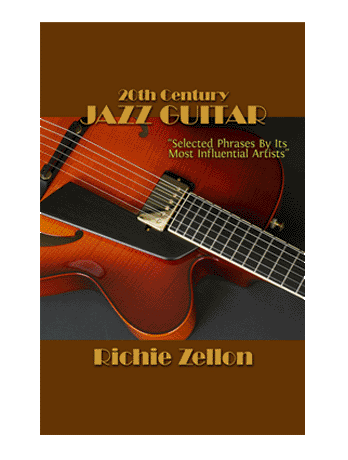Barry Harris 6th & Diminished Chords
For some time now, several students have been asking me to do a lesson on how to use the “6th and diminished” harmonized scales associated with the late bebop pianist, Barry Harris. However, I’ve been hesitant because personally, it’s a concept I picked up over the years transcribing some block chord solos by Wes Montgomery.
Only after being exposed to the Barry Harris system in recent years, did I notice this connection…
If you analyze almost any Wes chord melody solo, you will notice that all of the same principles in the Barry Harris system are in place! I’m not claiming that Wes necessarily learned it from Barry Harris, or was thinking of his use of chords in those terms. As I point out in this lesson, there are other means to achieve the same effect. Nonetheless, I believe it is a well organized system that is guaranteed to bring about those moving “block chord” sequences that Wes often employed in his solos.
In this video I demonstrate the basics of the Barry Harris system as applied to comping and creating chord melody. I show you in detail, how each scale is formed, how to generate chord voicings from them, and how to use them to harmonize any melody using a well known tune!
PDF & AUDIO DOWNLOAD:
The Barry Harris 6th & Diminished Chords lesson files, can be downloaded for $10.00. The download includes the following files: 12 page PDF with both regular notation and TAB of all the examples & theory, MP3s of all the examples, a Band in a Box file of the “Ode to Joy” arrangement, and Midi file so you can practice using the free downloadable notation app: “Muse Score”.
[Content protected for Elite, Elite 3 Month, Elite 6 Month members only]
6 Comments
Submit a Comment
You must be logged in to post a comment.

Hello Richie,
I tried to download the lesson “6th an diminishes” but it didn´t work when I tried to make the paymend by paypal.
What ca I do to get the sheets?
E-Mail: hhzeug@gmx.de
Greetings from bavaria in the south of germany!
Hannes
Hi Hannes,
Please send me an email to jazzguitar@richiezellon.com and let me know in detail what happens when you try to make your payment, so I can help you.
Hello,
in the meantime it seemed to me that the reason is that Iám not part of the needed category of membership do paypal sent me back to your site.
Is there any way to get the download the PDF of “6th and dimishedes”?
Greetings
You don’t have to be an Elite member to purchase any lesson. Just log in and go to the 6th and Diminished post. You will find instructions there above the PayPal icon. If you have additional questions, please send me an email to jazzguitar@richiezellon.com
I am also working on the first year of the bebop course in your bebopguitar course.
I became acquainted with Barry Harris’ work quite a few years ago. I noticed that other guitarists were using his harmonies of the scales and his methods, and I bought a package containing Barry Harris’ course work to find out more. I liked the sound of Barry’s music, and I began to think of what he did as a systematic overall re-harmonization of jazz tunes. Other more advanced improvisers appeared to be able to play beautiful lines against the chords that resulted from a Berry Harris re-harmonization, but I was not always so quick to catch on. Barry Harris’ method material is still on my bookshelf, but not really under my fingers. For example, I still tend to think in terms of ii V I, a resolution that still uses the dominant chord in a way that Barry appears to avoid.
To use your own words, “The use of arpeggios…and the concept of targeting them with diatonic and chromatic approach tones has been an effective and widely accepted practice… .” Perhaps I will eventually begin to learn enough of the proper arpeggios and appropriate approach notes that will let me sound good against the chord progressions and resolutions that Barry played. Is there some shortcut that I have missed, or would I simply need to stay longer in the wood shed to begin to improvise comprehensive jazz solos against Barry’s work?
Thanks for your feedback! As you probably know if you are taking my bebop course, I am not a proponent of the Barry Harris approach to using his scales to improvise “single note lines”. I think it’s a nice concept to use in chord melody, although after studying conventional jazz harmony, I learned to do the same thing from a different perspective (which I find much easier and direct).
As a result of studying and hanging out with several great musicians (eg. Red Rodney, Jimmy Heath etc) who were contemporaries of Barry Harris, I know that this is not the way other bebop musicians approached jazz improvisation. Melodically speaking, they were thinking primarily of the chord arpeggio of the moment and targeting its notes with a variety of approach tones. I view the Barry Harris scale approach when applied to single note lines as a re-invention of the wheel. Myself, as well as many musicians I admire, also believe it misses out on several important concepts. But that is a subject requiring deeper discussion. In conclusion, this is the reason why it isn’t taught at most major jazz schools, except maybe as an elective!
All of this said, I think the his application for harmonizing with the “6th and diminished” is practical and well summed up in his formula! This of course will sometimes tend to yield a dated sound which is fine if that’s what you’re going for. On the other hand, if you’re going for that Bill Evans, Jim Hall and other post bop sounds, it won’t work…